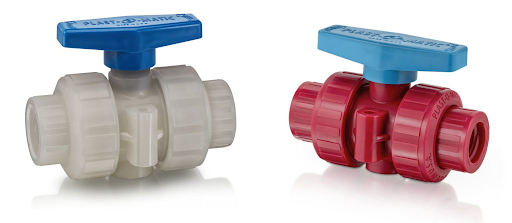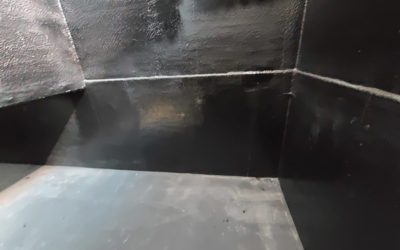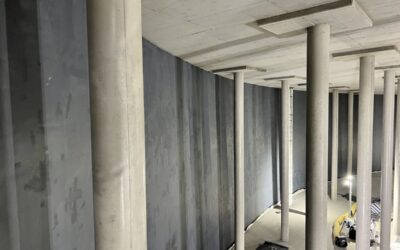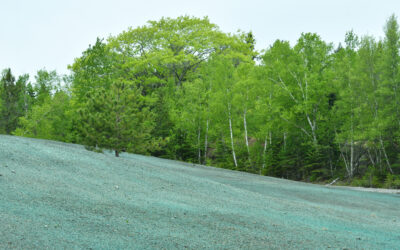Pipe can be manufactured from all sorts of materials, sizes, and configurations. At US FUSION, we work most often with various types of plastic piping, including HDPE, PolyPro, and PVDF.
In this article, we’re discussing PVDF. We talk about what PVDF is, how it’s made, when it’s used, and more.
What Is PVDF?
PVDF stands for polyvinylidene fluoride, which is a semi-crystalline, highly inert, stable thermoplastic fluoropolymer. It has a melting point of 347°F and service temperatures of up to 302°F. It boasts outstanding properties overall, such as great durability and toughness, excellent chemical resistance, high crystallinity, and good thermal stability.
PVDF is one of the best radiation-resistant plastics available in the market, only bested by PEEK (polyetheretherketone) and polyamide. Today it is sold under different brand names with various additives and melt flow rates, all of which increase the processing capabilities and heighten properties for specific applications.
How Is PVDF Made?
PVDF resin is produced by free-radical polymerization of 1,1-Difluoroethylene (abbreviation = DFE, chemical formula = C2H4F2). The polymerization occurs in the emulsion of 50-302°C and 10-300 atm pressure. The obtained material is then processed into films, rods, tubes, and sheets.
The most common methods to produce PVDF polymer are chlorotrifluoroethylene (CTFE) or hexafluoro propene (HFP). HFP-made PVDF copolymer shows higher flexibility compared to PVDF homopolymer grades. Copolymers made by CTFE are superior even yet to polymers made by HFP. They are more flexible, have low shrinkage, and have a fantastic low-temperature performance range.
Furthermore, polyvinylidene fluoride is exposed to ionizing radiation using crosslinking, making various modifications to the thermal and mechanical properties possible. Additionally, different resins like methacrylic and acrylic rubbers have partial compatibility with the polymer.
Mechanical Properties of PVDF
PVDF has a good tensile modulus but fairs weak in the impact strength department. Rearrangements done using HFP and CTFE can help improve the flexibility and impact strength, as well as decrease the tensile modulus.
PVDF is also non-flammable and won’t drip. It is self-extinguishing and has decent resistance to UV light.
IS PVDF Acid Resistant?
PVDF exhibits excellent chemical- and acid-resistant properties. It can withstand a variety of aggressive fluids and solvents. It mainly shows impressive physical resistance toward organic and inorganic acids, halogenated solvents, and hydrocarbons.
PVDF Applications
PVDF has many applications, in all sorts of industries. Here are a few common examples.
Electrical/Electronics
PVDF has many applications in the electrical and electronics industries, such as:
- Wires and cables in aircraft
- High-temperature wirings
- Home appliances
- Wire coating
- Industrial power control systems
Heavy Industries
With help from common additives, PVDF’s good corrosion properties can improve its applicability to heavy industries like oil and gas, automotive, marine, and petrochemicals used for gaskets, seals, and linings. Lately, it is most commonly used in filtration equipment like housings, filters, membranes, etc.
Batteries
PVDF is also used for making separators in lithium-ion batteries, thanks to their reliable thermal and chemical stability. These membranes are in demand as the market for electric mobility will see sizable growth in the future.
Piping and Liners
Chemical processing equipment depends on PVDF resin to make flexible piping, tubing, and liners to be used in water systems, chemical pipes, automobile fuel lines, and storage. Piezoelectric films are very sensitive transducers. They are malleable, rigid, and lightweight; thus, they can be shaped into various geometries resulting in unique and innovative applications.
Coatings
PVDF is also used for coating and layering applications on metals like aluminum and galvanized steel. The coatings improve these materials’ chemical resistance and weatherability.
What Is Red PVDF?
PVDF red piping systems have been used successfully in outdoor applications for over 25 years. Red PVDF provides the same pressure/temperature range and chemical resistance as traditional Kynar® PVDF with no pigmentation.
Natural, unpigmented PVDF is unaffected by ultraviolet (UV) light, but is does permit UV rays to pass through it, affecting the media within the pipeline. Since UV rays pass through natural Kynar® PVDF, chlorine or peroxide can cause stress cracks in Kynar® components.
By adding a specific red pigment to Kynar® PVDF, the UV light spectrum is unable to pass through the polymer. This protects the media within and eliminates the potential of UV rays to radicalize the chemicals.
Red PVDF not only protects the material chemistry but also extends the service life of the piping system. The red pigment also enables the material to better withstand weathering and outdoor exposure.
However, red pigmented Kynar® PVDF is not usually recommended for indoor use with high-purity systems such as deionized water, as it can potentially leach impurities into the media.

Contact US FUSION for Your PVDF Pipe & Fittings Needs
At US FUSION, we have the capabilities to supply, fuse, and install high-performance PVDF pipes and fittings. Our cost-effective solutions, comprehensive inventory, and custom services can meet any demand or project scope. Give our team a call or contact us online to get started.







